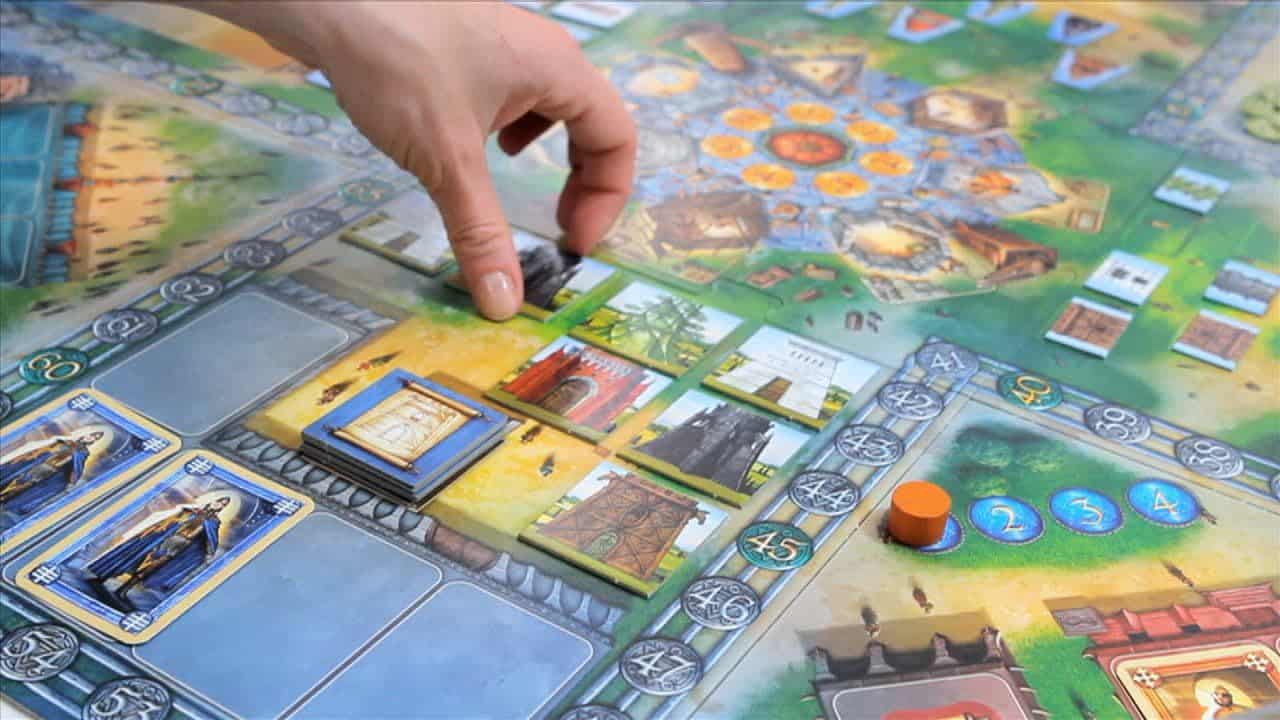Asara is a strategic board game that transports players to the vibrant world of Renaissance-era builders and architects. In this game, players take on the roles of master builders, competing to construct the most prestigious towers in the city of Asara.
Players will bid on construction plans, collect building materials, and recruit skilled workers to construct towers. The game’s mechanics involve a clever combination of card drafting, resource management, and worker placement. Asara is not only a test of architectural prowess but also a race to earn prestige, making it an engaging and visually appealing game for fans of strategy and city-building themes.
What’s included in Asara?

- Game Board: Represents the city of Asara with various districts.
- Building Cards: Show the tower designs you can build.
- Construction Cards: Determine turn order and available actions.
- Resource Cards: Represent building materials like bricks and money.
- Worker Cards: Depict skilled laborers to help with construction.
- Prestige Points: The currency of the game used to determine the winner.
- Tower Markers: Represent your towers on the board.
How to play Asara

Asara is a strategic board game that allows players to become master builders in the bustling city of Asara. In this game, your goal is to earn prestige points by constructing the most impressive towers. Here’s a detailed guide on how to play.
Setup
- Place the game board in the center of the table.
- Shuffle the Building Cards and create a face-down deck.
- Shuffle the Construction Cards and place them face-down.
- Create a supply of Resource Cards and Prestige Points.
- Each player receives a set of Worker Cards, Tower Markers, and a starting amount of Prestige Points and Resource Cards.
Rules for Asara
Asara is played over a series of rounds, each consisting of several phases:
- Construction Card Phase:
- Reveal the top Construction Card, which determines the turn order and available actions for the round.
- Resource Collection Phase:
- Players collect resource cards according to the worker cards they have in play.
- Building Phase:
- Players take turns either purchasing a Building Card or constructing a tower.
- To purchase a Building Card, pay the required resources and add it to your hand.
- To construct a tower, play a Building Card from your hand and pay the resource cost listed on the card.
- Towers must be placed in a district where you have a worker card.
- The height of the tower must be equal to or less than the number of workers you have in that district.
- Gain Prestige Points equal to the tower’s height.
- Replace the Building Card you used with a new one from the deck.
- Worker Placement Phase:
- Players take turns placing worker cards on districts to gain bonuses or control districts.
- Control of a district allows you to construct towers there in future rounds.
- End of Round:
- Discard the Construction Card.
- Return any unused Building Cards to the deck.
- Rotate the Start Player token clockwise.
End of the Game: The game continues for a set number of rounds (determined by the number of players). After the final round, players tally their Prestige Points from constructed towers, bonuses, and completed objectives on Building Cards. The player with the most Prestige Points wins the game.
For the official rules, see the link below:
How to win Asara

- Efficient Resource Management:
- Resource cards are essential for building towers and acquiring worker cards. Ensure you efficiently collect the necessary resources to construct your towers and acquire worker cards. Balancing your resource acquisition is crucial.
- Worker Card Placement:
- Placing worker cards strategically on districts allows you to control those areas and build higher towers in the future. Prioritize worker card placement in districts where you plan to construct significant towers.
- Tower Height vs. District Control:
- Decide whether you want to focus on constructing taller towers for immediate Prestige Points or on controlling districts for long-term benefits. Balancing these two objectives is key to success.
- Building Card Selection:
- Choose Building Cards that align with your strategy. Look for cards that match your worker card placement and resource collection patterns. Completing objectives on Building Cards can provide valuable bonus Prestige Points.
- Adapt to the Construction Card Phase:
- The Construction Card phase determines turn order and available actions. Adapt your strategy based on the available actions. For example, if you have a chance to build a tower before other players, seize the opportunity.
- Compete for High-Value Building Cards:
- Some Building Cards offer higher Prestige Points and bonuses. Compete with other players to acquire these cards when they become available. Just be mindful of the resource costs.
- Worker Card Abilities:
- Utilize the special abilities of your worker cards strategically. Some abilities can greatly enhance your resource collection or district control.
- Contest District Control:
- If an opponent is dominating a district you wish to control, consider contesting it. The player with the most workers in a district controls it. Controlling districts gives you more options for tower construction.
- Objective Completion:
- Building Cards with objectives can be a significant source of Prestige Points. Try to complete these objectives while constructing your towers.
- Watch Your Opponents:
- Pay attention to your opponents’ strategies and actions. If you notice someone pursuing a particular strategy, consider adapting yours to counter or outperform them.
- Final Rounds and Scoring:
- Plan your actions in the final rounds to maximize your Prestige Points. Completing objectives, constructing high towers, and controlling districts should be your focus.